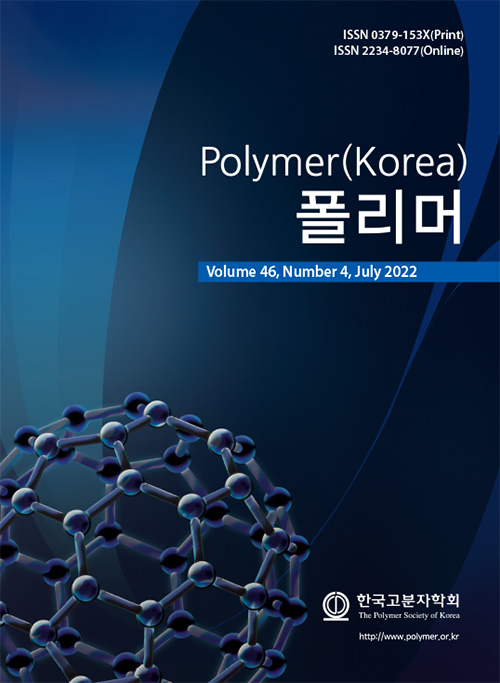- Particulate Reinforcements in Dicyanate Composites with Nanoporous Aluminum Fumarate as Reactive Filler: Thermal Properties
Siva Kaylasa Sundari Saravanamuthu
 , Shamim Rishwana Syed Mohammed
, Shamim Rishwana Syed Mohammed , Ramani Ramasubbu*, Arunjunai Raj Mahendran**, and Vijayakumar Chinnaswamy Thangavel***,†
, Ramani Ramasubbu*, Arunjunai Raj Mahendran**, and Vijayakumar Chinnaswamy Thangavel***,†
Department of Chemistry, Kamaraj College of Engineering and Technology (Autonomous), S.P.G.C. Nagar, K. Vellakulam-625701, Tamil Nadu, India
*Defence Bio-Engineering and Electromedical Laboratory, ADE Campus, C.V. Raman Nagar, Bengaluru-560093, Karnataka, India
**Kompetenzzentrum Holz GmbH (W3C), Klagenfurter Straße 87-89, A-9300 St. Veit an der Glan, Austria
***Department of Polymer Technology, Kamaraj College of Engineering and Technology (Autonomous), S.P.G.C. Nagar, K. Vellakulam-625701, Tamil Nadu, India- 반응성 필러로써 Aluminum Fumarate을 이용한 Dicyanate Composites의 물성 강화: 열역학적 특성 연구
Reproduction, stored in a retrieval system, or transmitted in any form of any part of this publication is permitted only by written permission from the Polymer Society of Korea.
In this work, the synthesized nanoporous aluminum fumarate (Al_FA_A) metal organic framework (MOF) has been used as reactive filler for the bisphenol-A dicyanate (BADCy) resin system. The use of Al_FA_A is interesting due to the involvement of double bonds (fumarate) in triazine during polymerization. The thermal properties of the polymers formed with and without reactive filler were evaluated under different curing temperatures, prepolymerizations and postpolymerizations conditions. All the samples were characterized by Fourier transform infrared spectroscopy (FTIR), thermogravimetric analysis (TGA), differential scanning calorimetry (DSC) and X-ray diffraction analysis (XRD) and Evolved gas analysis. On the contrary, the cure chemistry was determined by non-isothermal model free kinetic methods. This study provides a new path to utilize the MOFs as reactive nanoparticle fillers to obtain multifunctional materials.
Keywords: particle reinforcement, high-temperature properties, thermal analysis, hybrid nanocomposite.
- Polymer(Korea) 폴리머
- Frequency : Bimonthly(odd)
ISSN 0379-153X(Print)
ISSN 2234-8077(Online)
Abbr. Polym. Korea - 2022 Impact Factor : 0.4
- Indexed in SCIE
 This Article
This Article
-
2022; 46(4): 426-435
Published online Jul 25, 2022
- 10.7317/pk.2022.46.4.426
- Received on Aug 27, 2021
- Revised on Apr 30, 2023
- Accepted on May 20, 2022
 Correspondence to
Correspondence to
- Vijayakumar Chinnaswamy Thangavel
-
Department of Polymer Technology, Kamaraj College of Engineering and Technology (Autonomous), S.P.G.C. Nagar, K. Vellakulam-625701, Tamil Nadu, India
- E-mail: ctvijay22@yahoo.com









 Copyright(c) The Polymer Society of Korea. All right reserved.
Copyright(c) The Polymer Society of Korea. All right reserved.